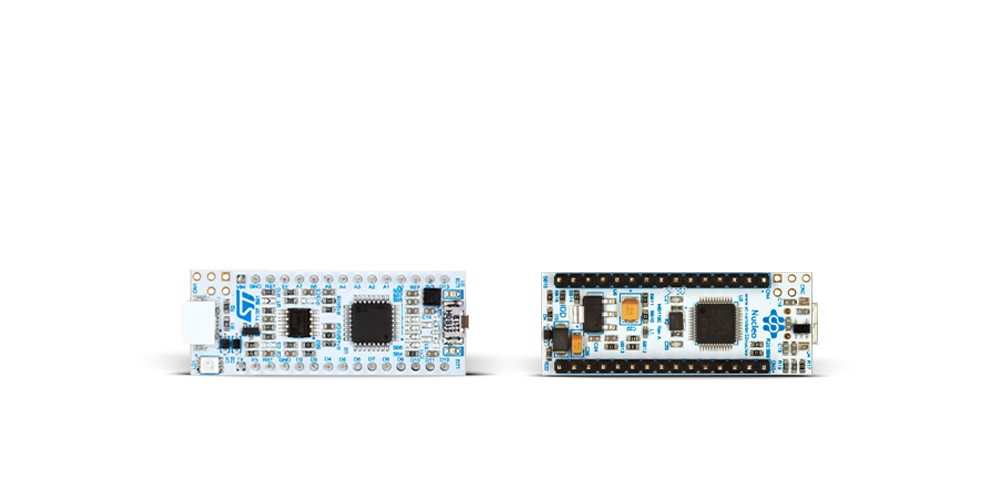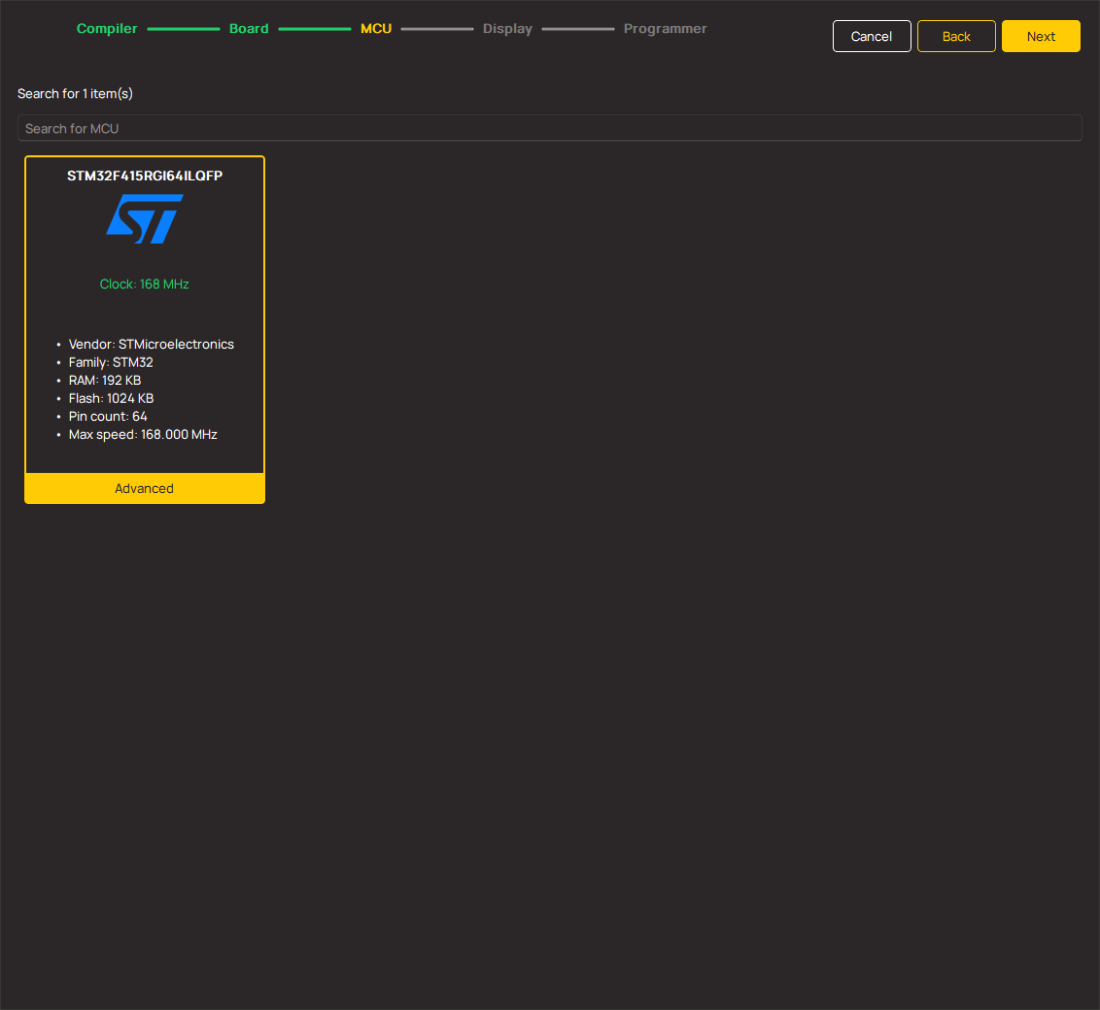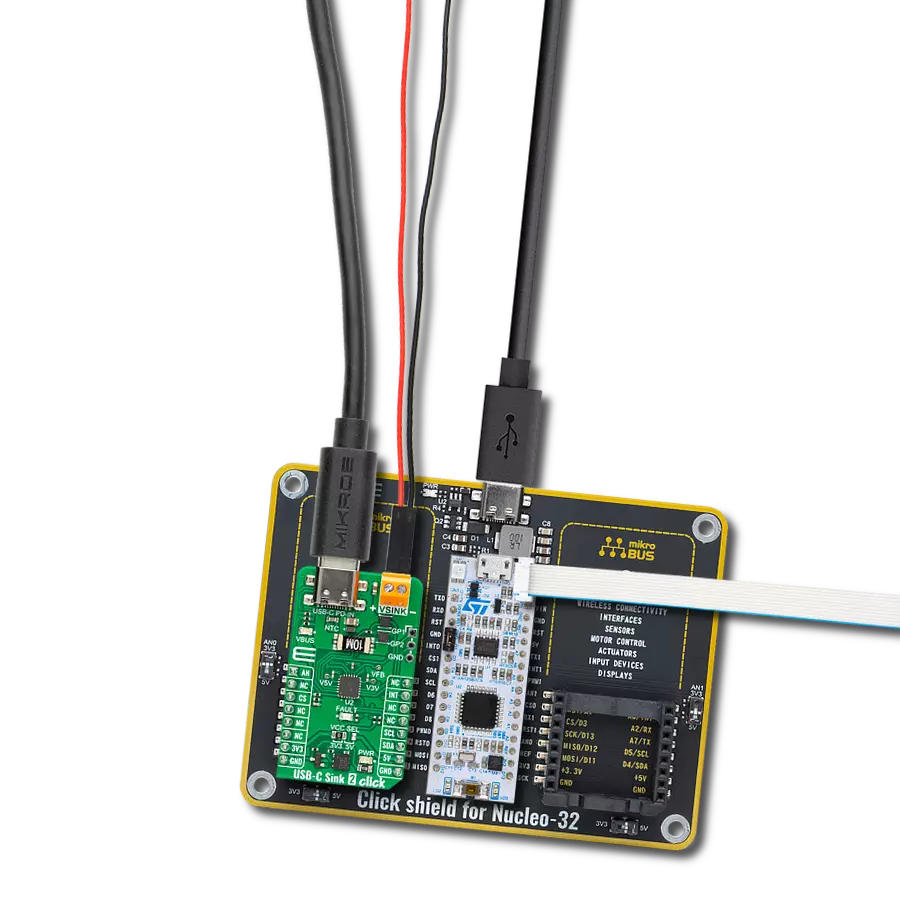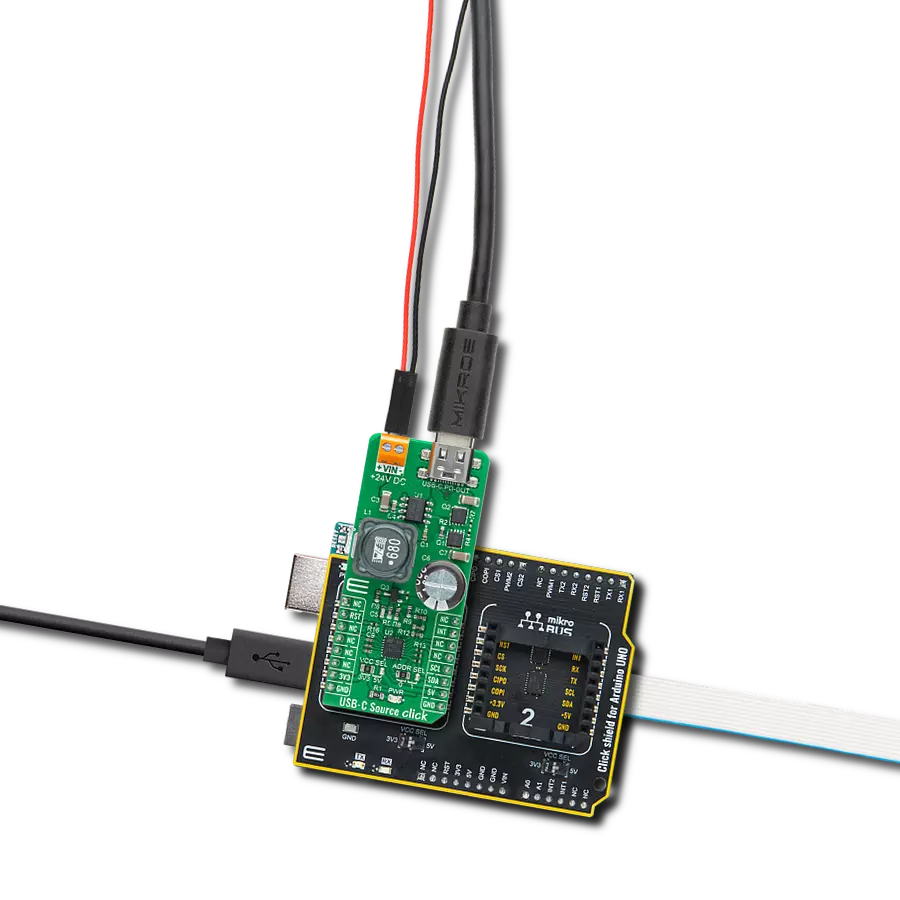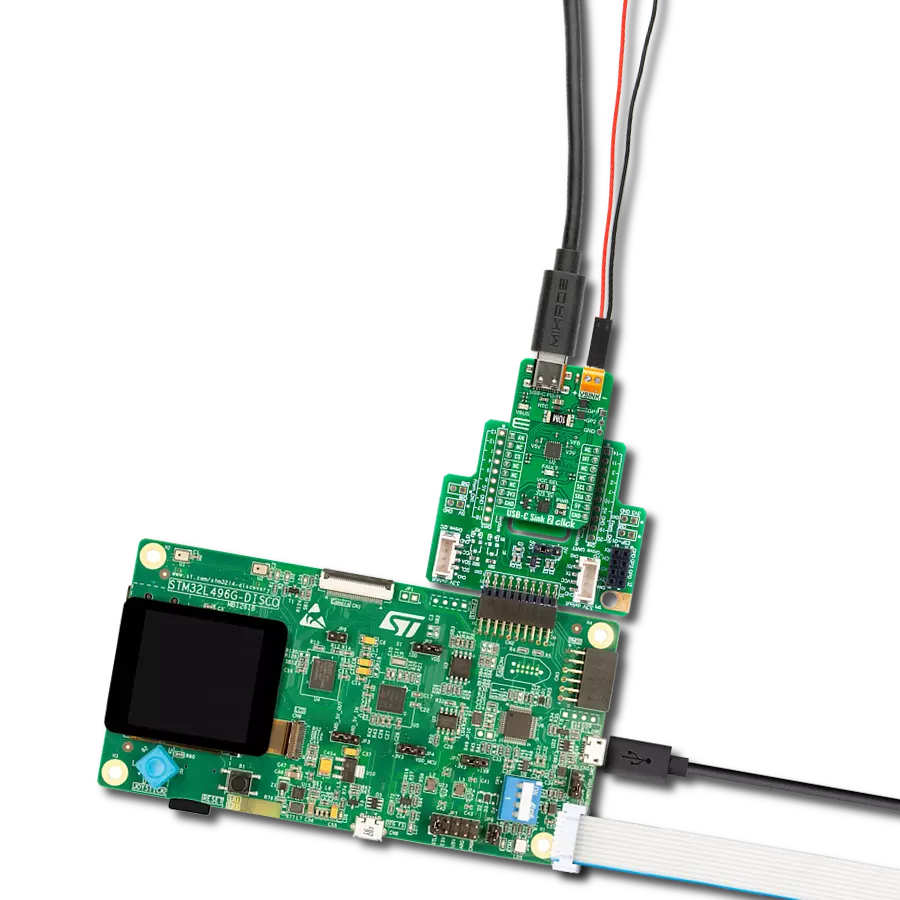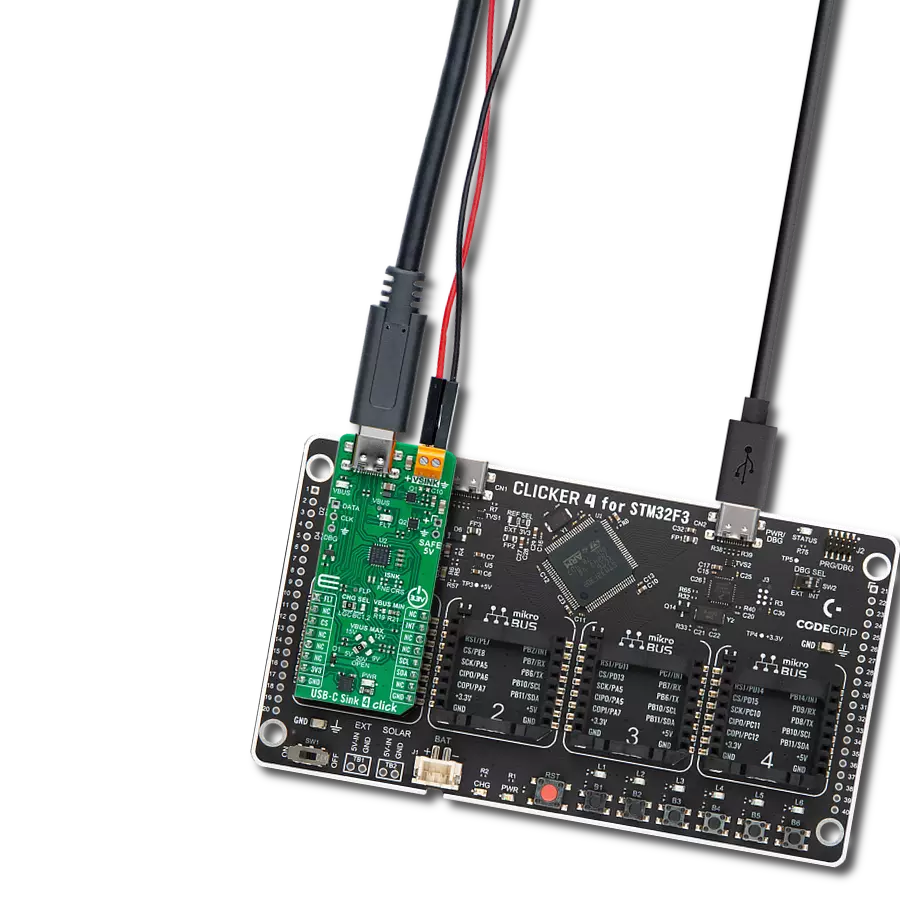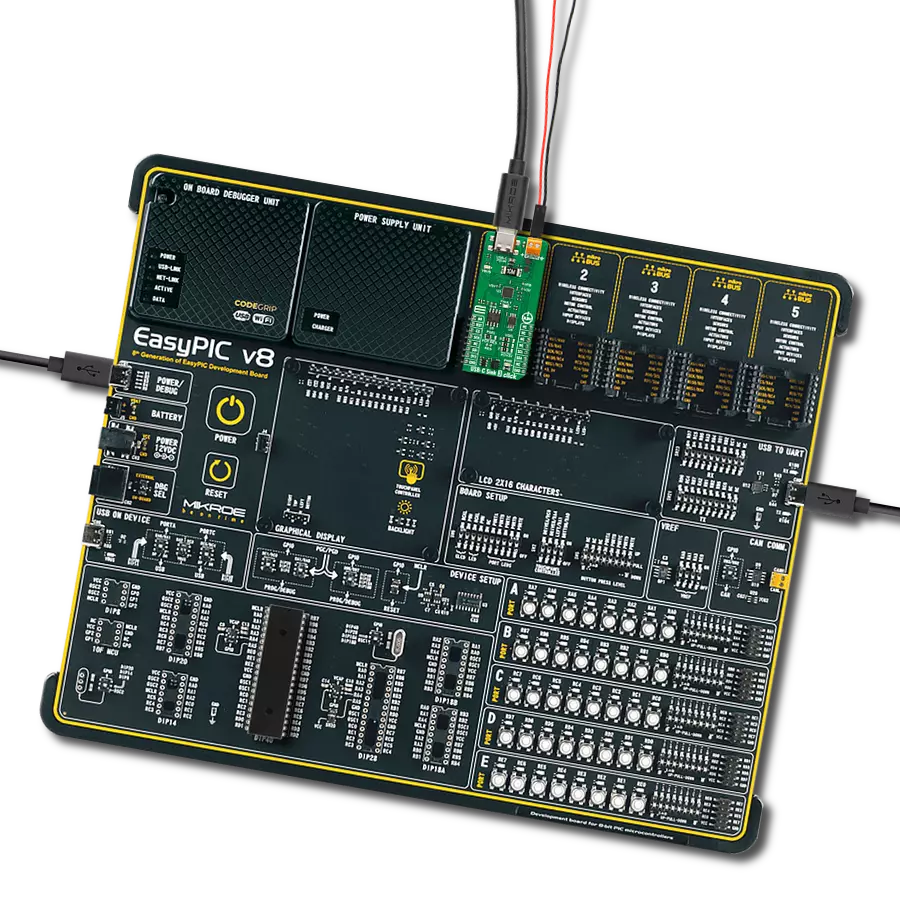Our USB Type-C PD controller unleashes the full potential of USB Type-C, allowing you to charge, transfer data, and connect to a world of peripherals like never before.
A
A
Hardware Overview
How does it work?
USB-C Power Click is based on the TPS25750S, a USB Type-C and Power Delivery (PD) controller from Texas Instruments, providing cable plug and orientation detection for a single USB Type-C connector. The TPS25750S communicates on the CC wire upon cable detection using the USB PD protocol. When cable detection and USB PD negotiation are complete, the TPS25750S enables the appropriate power path for sourcing or sinking power on the USB IN-OUT connector, depending on the set configuration. The TPS25750S is highly optimized for applications supporting USB-C PD Power and provides robust protection and fully managed internal power paths (5V/3A with 36mΩ sourcing switch). The second USB connector, marked with 5V IN, serves to supply 5V voltage in the form of a USB connection, which is necessary for the internal 5V sourcing power path. This Click board™ communicates with MCU using the standard I2C 2-Wire interface to read data and configure settings with a maximum frequency of 400kHz. In addition, it also possesses an additional
interrupt signal routed on the IRQ pin of the mikroBUS™ socket. Besides the I2C port for communication with the host MCU, the TPS25750S has one additional I2C interface in Master configuration with a maximum frequency of 400kHz, which will connect to the battery charger like BQ25792 for example (or external EEPROM), to communicate the proper configurations to set it up for charging mode, charging current, OTG mode, and many more. The BQ25792 is a fully integrated switch-mode buck-boost charger for 1-4 cell Li-ion and Li-polymer batteries, allowing users to source or sink high power up to 3A. The necessary power supply and lines for communication with the battery charger are located on unpopulated headers on the right side of the board. Thanks to the onboard ADC jumpers, the TPS25750S can set the dead battery configuration and the I2C slave address for the PD controller based on their position. Two offered dead battery configurations are Safe mode and Always Enable Sink. The Safe mode does not
enable the sink path, and USB PD is disabled until the configuration is loaded. In the Always Enable Sink mode, the device enables the sink path, regardless of the current amount the attached source offers. The USB PD is disabled until the configuration is loaded. This Click board™ also features two GPIO signals, located on unpopulated headers, that are user-defined for status and control information. GPIO pins can be mapped to USB Type-C, USB PD, and application-specific events to control other ICs, interrupt a host processor, or receive input from other ICs. Along with the GPIOs, it also has two LED indicators, IO0 and IO1, for the realization of visual detection of some anomalies or statuses during operation. This Click board™ can be operated only with a 3.3V logic voltage level. The board must perform appropriate logic voltage level conversion before using MCUs with different logic levels. Also, it comes equipped with a library containing functions and an example code that can be used as a reference for further development.
Features overview
Development board
Nucleo 32 with STM32F031K6 MCU board provides an affordable and flexible platform for experimenting with STM32 microcontrollers in 32-pin packages. Featuring Arduino™ Nano connectivity, it allows easy expansion with specialized shields, while being mbed-enabled for seamless integration with online resources. The
board includes an on-board ST-LINK/V2-1 debugger/programmer, supporting USB reenumeration with three interfaces: Virtual Com port, mass storage, and debug port. It offers a flexible power supply through either USB VBUS or an external source. Additionally, it includes three LEDs (LD1 for USB communication, LD2 for power,
and LD3 as a user LED) and a reset push button. The STM32 Nucleo-32 board is supported by various Integrated Development Environments (IDEs) such as IAR™, Keil®, and GCC-based IDEs like AC6 SW4STM32, making it a versatile tool for developers.
Microcontroller Overview
MCU Card / MCU
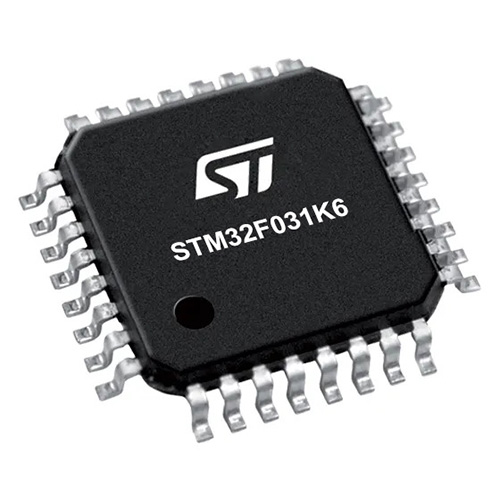
Architecture
ARM Cortex-M0
MCU Memory (KB)
32
Silicon Vendor
STMicroelectronics
Pin count
32
RAM (Bytes)
4096
You complete me!
Accessories
Click Shield for Nucleo-32 is the perfect way to expand your development board's functionalities with STM32 Nucleo-32 pinout. The Click Shield for Nucleo-32 provides two mikroBUS™ sockets to add any functionality from our ever-growing range of Click boards™. We are fully stocked with everything, from sensors and WiFi transceivers to motor control and audio amplifiers. The Click Shield for Nucleo-32 is compatible with the STM32 Nucleo-32 board, providing an affordable and flexible way for users to try out new ideas and quickly create prototypes with any STM32 microcontrollers, choosing from the various combinations of performance, power consumption, and features. The STM32 Nucleo-32 boards do not require any separate probe as they integrate the ST-LINK/V2-1 debugger/programmer and come with the STM32 comprehensive software HAL library and various packaged software examples. This development platform provides users with an effortless and common way to combine the STM32 Nucleo-32 footprint compatible board with their favorite Click boards™ in their upcoming projects.
Used MCU Pins
mikroBUS™ mapper
Take a closer look
Click board™ Schematic
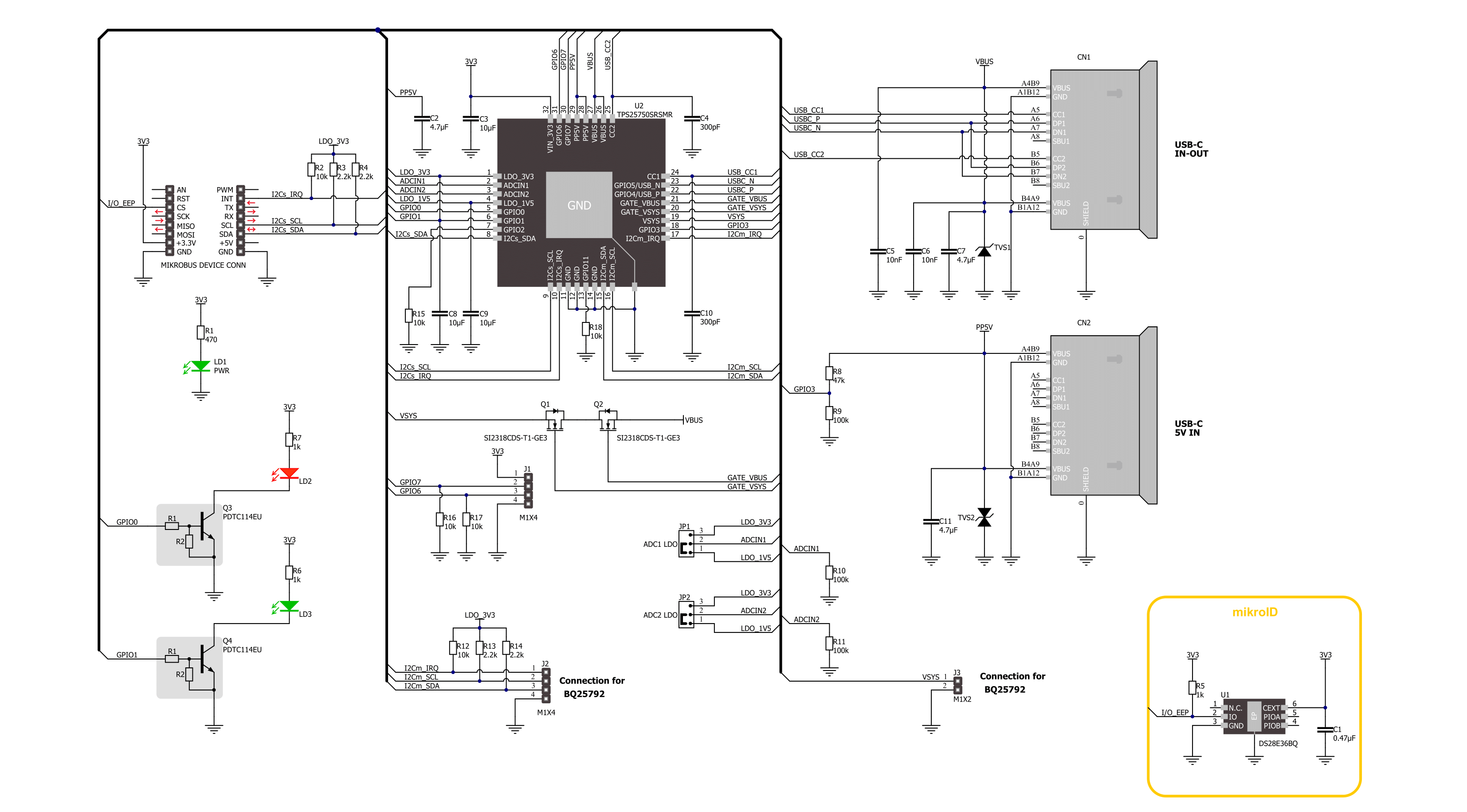
Step by step
Project assembly
Software Support
Library Description
This library contains API for USB-C Power Click driver.
Key functions:
usbcpower_get_status- USB-C Power gets status function.usbcpower_get_pwr_status- USB-C Power gets PWR status function.usbcpower_start_patch_burst_mode- USB-C Power starts the patch burst mode function.
Open Source
Code example
The complete application code and a ready-to-use project are available through the NECTO Studio Package Manager for direct installation in the NECTO Studio. The application code can also be found on the MIKROE GitHub account.
/*!
* @file main.c
* @brief USB-C Power Click example
*
* # Description
* This example demonstrates the use of the USB-C Power Click board™
* by configuring the PD controller to attempt to become a Power Source.
*
* The demo application is composed of two sections :
*
* ## Application Init
* The initialization of I2C module, log UART, and additional pins.
* After the driver init, the app executes a default configuration,
* depending on PD Device Mode, the app performs the patch bundle update tasks
* for loading a patch bundle in burst mode to the PD controller.
*
* ## Application Task
* The application display status information about
* the PD controller data role and power of the connection.
* Results are being sent to the UART Terminal, where you can track their changes.
*
* ## Additional Function
* - static void usbcpower_display_status ( void )
* - static void usbcpower_display_pwr_status ( void )
*
* @note
* For the advanced configuration, use the TPS25750 Application Customization Tool:
* https://dev.ti.com/gallery/search/TPS25750_Application_Customization_Tool
*
* @author Nenad Filipovic
*
*/
#include "board.h"
#include "log.h"
#include "usbcpower.h"
static usbcpower_t usbcpower;
static log_t logger;
static uint32_t response;
static usbcpower_status_t status;
static usbcpower_pwr_status_t pwr_status;
/**
* @brief USB-C Power display status function.
* @details This function display status information.
* @return Nothing.
* @note None.
*/
static void usbcpower_display_status ( void );
/**
* @brief USB-C Power display PWR status function.
* @details This function display power of the connection status information.
* @return Nothing.
* @note None.
*/
static void usbcpower_display_pwr_status ( void );
void application_init ( void )
{
log_cfg_t log_cfg; /**< Logger config object. */
usbcpower_cfg_t usbcpower_cfg; /**< Click config object. */
/**
* Logger initialization.
* Default baud rate: 115200
* Default log level: LOG_LEVEL_DEBUG
* @note If USB_UART_RX and USB_UART_TX
* are defined as HAL_PIN_NC, you will
* need to define them manually for log to work.
* See @b LOG_MAP_USB_UART macro definition for detailed explanation.
*/
LOG_MAP_USB_UART( log_cfg );
log_init( &logger, &log_cfg );
log_info( &logger, " Application Init " );
// Click initialization.
usbcpower_cfg_setup( &usbcpower_cfg );
USBCPOWER_MAP_MIKROBUS( usbcpower_cfg, MIKROBUS_1 );
if ( I2C_MASTER_ERROR == usbcpower_init( &usbcpower, &usbcpower_cfg ) )
{
log_error( &logger, " Communication init." );
for ( ; ; );
}
if ( USBCPOWER_ERROR == usbcpower_default_cfg ( &usbcpower ) )
{
log_error( &logger, " Default configuration." );
for ( ; ; );
}
usbcpower_set_patch_mode( &usbcpower, &response );
if ( USBCPOWER_RSP_OK != response )
{
log_error( &logger, " Go to Patch Mode." );
for ( ; ; );
}
uint8_t device_mode[ 6 ] = { 0 };
usbcpower_get_device_mode( &usbcpower, &device_mode );
log_printf( &logger, " PD Device Mode: %s\r\n", &device_mode[ 1 ] );
log_printf( &logger, "-----------------------------\r\n" );
Delay_ms ( 100 );
log_info( &logger, " Application Task " );
log_printf( &logger, "-----------------------------\r\n" );
Delay_ms ( 100 );
}
void application_task ( void )
{
if ( USBCPOWER_OK == usbcpower_get_status( &usbcpower, &status ) )
{
if ( USBCPOWER_OK == usbcpower_get_pwr_status( &usbcpower, &pwr_status ) )
{
usbcpower_display_status( );
log_printf( &logger, "- - - - - - - - - - - - - - -\r\n" );
usbcpower_display_pwr_status( );
log_printf( &logger, "-----------------------------\r\n" );
}
}
Delay_ms ( 1000 );
Delay_ms ( 1000 );
Delay_ms ( 1000 );
}
int main ( void )
{
/* Do not remove this line or clock might not be set correctly. */
#ifdef PREINIT_SUPPORTED
preinit();
#endif
application_init( );
for ( ; ; )
{
application_task( );
}
return 0;
}
static void usbcpower_display_status ( void )
{
if ( status.plug_present )
{
log_printf( &logger, " A plug is connected.\r\n" );
}
else
{
log_printf( &logger, " No plug is connected\r\n" );
}
if ( USBCPOWER_STATUS_NO_CONNECTION == status.conn_state )
{
log_printf( &logger, " No connection.\r\n" );
}
else if ( USBCPOWER_STATUS_PORT_DISABLED == status.conn_state )
{
log_printf( &logger, " Port is disabled.\r\n" );
}
else if ( USBCPOWER_STATUS_AUDIO_CONNECTION == status.conn_state )
{
log_printf( &logger, " Audio connection (Ra/Ra).\r\n" );
}
else if ( USBCPOWER_STATUS_DEBUG_CONNECTION == status.conn_state )
{
log_printf( &logger, " Debug connection (Rd/Rd).\r\n" );
}
else if ( USBCPOWER_STATUS_NO_CONNECTION_Ra == status.conn_state )
{
log_printf( &logger, " No connection, Ra detected (Ra but no Rd).\r\n" );
}
else if ( USBCPOWER_STATUS_RESERVED == status.conn_state )
{
log_printf( &logger, " Reserved (may be used for Rp/Rp Debug connection).\r\n" );
}
else if ( USBCPOWER_STATUS_CONNECT_NO_Ra == status.conn_state )
{
log_printf( &logger, " Connection present, no Ra detected.\r\n" );
}
else
{
log_printf( &logger, " Connection present, Ra detected.\r\n" );
}
if ( status.plug_orientation )
{
log_printf( &logger, " Upside-down orientation.\r\n" );
}
else
{
log_printf( &logger, " Upside-up orientation.\r\n" );
}
if ( status.port_role )
{
log_printf( &logger, " PD Controller is Source.\r\n" );
}
else
{
log_printf( &logger, " PD Controller is in the Sink role.\r\n" );
}
}
static void usbcpower_display_pwr_status ( void )
{
if ( pwr_status.pwr_conn )
{
log_printf( &logger, " Connection present.\r\n" );
}
else
{
log_printf( &logger, " No connection.\r\n" );
}
if ( USBCPOWER_PWR_STATUS_USB == pwr_status.type_c_current )
{
log_printf( &logger, " USB Default Current.\r\n" );
}
else if ( USBCPOWER_PWR_STATUS_TYPE_C_1_5A == pwr_status.type_c_current )
{
log_printf( &logger, " Type-C Current: 1.5 A\r\n" );
}
else if ( USBCPOWER_PWR_STATUS_TYPE_C_3_0A == pwr_status.type_c_current )
{
log_printf( &logger, " Type-C Current: 3.0 A\r\n" );
}
else
{
log_printf( &logger, "Explicit PD contract sets current.\r\n" );
}
if ( USBCPOWER_PWR_STATUS_CHG_ADV_DISABLE == pwr_status.charger_advertise )
{
log_printf( &logger, " Charger advertise disabled or not run.\r\n" );
}
else if ( USBCPOWER_PWR_STATUS_CHG_ADV_PROCESS == pwr_status.charger_advertise )
{
log_printf( &logger, " Charger advertisement in process.\r\n" );
}
else if ( USBCPOWER_PWR_STATUS_CHG_ADV_COMPLETE == pwr_status.charger_advertise )
{
log_printf( &logger, "Charger advertisement complete.\r\n" );
}
else
{
log_printf( &logger, "Reserved.\r\n" );
}
}
// ------------------------------------------------------------------------ END
Additional Support
Resources
Category:USB-C PD


